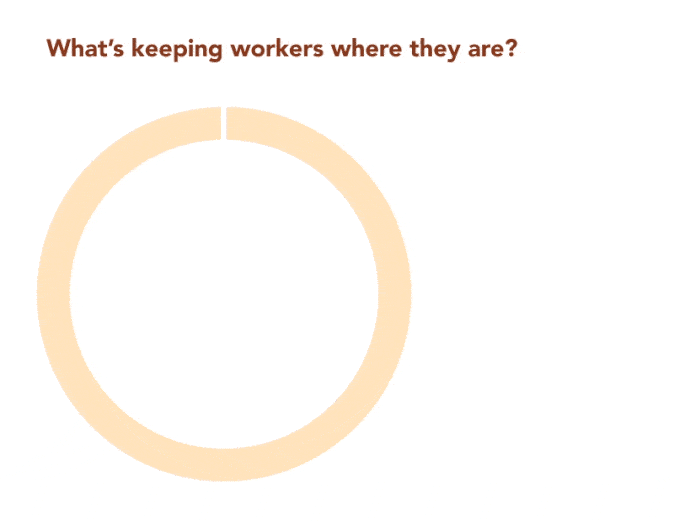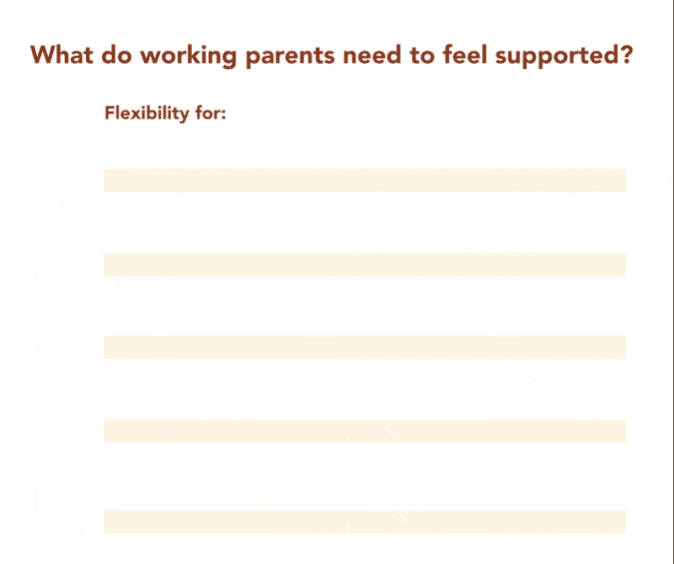Human Workplace Index: Shifting Workplace Priorities During Times of Uncertainty

Organizations across industries have drastically shifted how they operate – not only in terms of where work gets done, but also the way employers communicate and support their employee base. The cause of these massive shifts? Crisis and uncertainty undoubtedly play a large part.
And what these moments of crisis and uncertainty show us is that employees will do their best work if their company is giving the same back to them, even amidst external challenges. We may not control when these events happen or the consequences they bring, but leaders can – and should – learn and grow from them.
With that as a backdrop, this month’s Human Workplace Index (HWI) looks at how employees are feeling in our current business landscape – a landscape with budding uncertainties and an economic downturn looming on the horizon.
Keep reading for key insights from this month’s survey. You can also check out previous iterations of the HWI here.
1. Hybrid, remote, in-person, oh my!
Uncommon as it once was, the hybrid work model is proving to be a persistent trend, with one-half of this month’s respondents reporting a preference toward hybrid or fully remote work, and the other preferring in-person (49.9% versus 50.1%, respectively).
It seems like workers are getting a say in this decision, as 66.5% of respondents report their working preferences align with their company’s return-to-office requirements.
Employees may be feeling heard right now, but based on the recent uptickOpens in a new tab in companies asking their workers to return, they may start to feel differently. This month’s survey found that of those who work hybrid or fully remote, 51% would leave their job if returning to work became a mandate.

2. Pulse check on the economy
When signs start pointing to an economic downturn, organizations’ knee-jerk reaction is usually to cut costs. This might be the right approach for some items on the balance sheet, but employees are more than a number in a cell. In fact, they are an organization’s most important asset.
This month, 67% of respondents said they were very likely to definitely planning to stay at their current company. When asked why, 26.1% responded that they have good benefits and another 20% cited their compensation.

It isn’t a surprise that a strong benefits package and fair compensation are two coveted things in times of economic uncertainty. Ironically enough, shrinking benefits and layoffsOpens in a new tab are also two of the things employers pull the reins on first when a recession hits.
Employees want to feel supported and valued by their company, and cutting employee-related costs first doesn’t come across as very supportive – especially not at a time when there are approximately two open jobs available per unemployed personOpens in a new tab. The grass may look greener – and unhappy workers are much more willing to take a chance to find out if it really is.
And while it’s promising to see most workers (66.5%) aren’t concerned about being laid off in the near future, 42.7% of workers are concerned that economic uncertainty will impact their job in some way. Workers’ biggest concerns include:
- People will be more stressed/tensions will be high – 61.6%
- Layoffs will cause us to be short-staffed – 45.7%
- I’ll be less likely to get a raise – 42.4%
- My hours will be cut – 37%
- I’ll have to work harder to prove my worth – 32.3%
- My pay will be reduced – 23.2%
Forward-thinking leaders will address and mitigate these concerns head-on so employees can continue to feel secure in their positions. Trimming the org chart may bring in short-term profits when cashflow is tight, but considering replacing an employee can cost up to 2x their salary, it might not be the best strategy.
Is the short-term gain worth losing talent with institutional knowledge and experience – just to replace them once things start looking up? It’s something worth thinking about.
3. Workplace safety
If employers want to bring workers back into the office – whether hybrid or in-person, recession or not – they should start with addressing any concerns. The good news is on personal level, 71.1% of workers say they agree with their manager on general workplace topics.
A psychologically safe relationship with a manager is great, but that doesn’t prevent all uncomfortable situations from arising in the workplace. When asked which uncomfortable situations workers have found themselves in, they answered:
- Seeing somebody else receive credit for my work – 36.6%
- Working with colleagues I clash with – 33.9%
- Overhearing negative comments about a colleague – 33.2%
- Being put on the spot in a meeting – 24.6%
Another question about uncomfortable workplace scenarios shed light on the needs of different people. Looking at all responses, “none of the above” found its way to the top, closely followed by “disagreeing with a manager” (30.5% and 30.2%, respectively).
- None of the above – 30.5%
- Disagreeing with my manager – 30.2%
- Having to go to my boss’s boss to resolve an issue – 25%
- Feeling uncomfortable by a colleague’s actions – 24.5%
- Raising an issue about a workplace friend – 22.3%
- Witnessing an inappropriate comment during a work call/meeting – 21.3%
- Filing a workplace misconduct complaint – 17.7%
- Racial bias/microaggressions – 10.7%
When we segment the data to look only at employees of color, however, the top response shifts. While “none of the above” was still a common answer at 27.6%, it was overtaken by “feeling uncomfortable by a colleague’s actions” (27.9%).
There are many benefits to in-person collaboration and connection, but at what cost? Considering one-half of remote/hybrid workers would rather quit than return to the office full-time, these types of experiences influence that decision.
That’s even more true for people of color, who are more likely to experience these uncomfortable situationsOpens in a new tab in the form of microaggressions or crude comments. Organizations that want to build trust and retain employees should keep this in mind – and begin work to mitigate these issues before requiring employees to return to a physical location.
4. Back to school
It’s September, and the back-to-school buzz is in the air. It sounds a bit different this year – concerns are buzzing around the heads of working parents, as 60% of them shared that the cost of back-to-school essentials has been a burden on their finances.
Rising inflation costs have impacted everyone, but working parents are being strained in more ways than just financial. In fact, there continues to be fear of judgment at work for having parent-related responsibilities.

This leads us to wonder what “feeling supported” really means, because a full 81.5% of working parents report feeling supported by their company. Based on the results above, it still seems like many organizations could do a lot more to truly create an inclusive and flexible work environment.
Creating that environment doesn’t have to be difficult; every working parent is unique, yet the data show they are worried about many of the same things, mostly around flexibility. This presents an opportunity for business leaders to do better for their people. If they don’t, these concerns will impact workers’ home and work lives and lead to increased stress and decreased productivity.
Leaders looking to get ahead of this should start by taking stock of these very real and common fears – from being a working parent to rising inflation and workplace safety – and then building specific solutions to address them. It won’t fix everything, but it will certainly help to make workers feel heard and valued – rather than judged and worried – and that’s a step in the right direction.
About the author
Sarah Bloznalis
Sarah Bloznalis is a content marketing specialist at Workhuman from Dorchester, Mass.